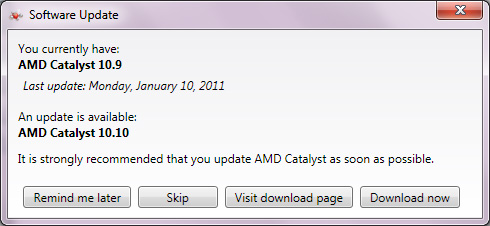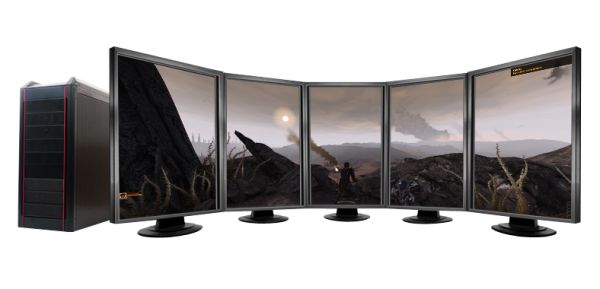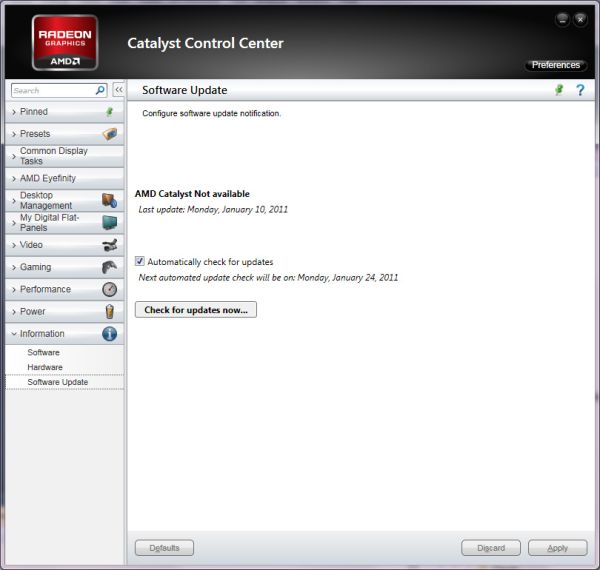AMD's Radeon HD 6990: The New Single Card King
by Ryan Smith on March 8, 2011 12:01 AM EST- Posted in
- AMD
- Radeon HD 6990
- GPUs
The launch drivers for the 6990 will be a preview version of Catalyst 11.4, which have been made available today and the final version launching sometime in April. Compared to the earlier drivers we’ve been using performance in most of our games is up by at least a few percent, particularly in CrossFire. For launching a dual-GPU card like the 6990, the timing couldn’t be better.
Along with these performance improvements AMD is also throwing a few new features in to the Catalyst Control Center, making it the first time they’ve touched it since the introduction of the new design in January. Chief among these features – and also timed to launch with the 6990 today - is 5x1 portrait Eyefinity mode. Previously AMD has supported 3x1 and 3x2, but never anything wider than 3 monitors (even on the Eyefinity 6 series).
The 6990 is of course perfectly suited for the task as it's able to drive 4 + 1 monitors without any miniDP MST hubs, and indeed the rendering capabilities of this card are wasted a good deal of the time only driving one monitor. Other cards will also support 5x1P, but only E6 cards can work without a MST hub at the moment. Notably, in spite of requiring one fewer monitor than 3x2 Eyefinity this is easily the most expensive option for Eyefinty yet, as portrait modes require monitors with wide vertical viewing angles to avoid color washout – you’d be hard pressed to build a suitable setup with cheap TN monitors like you can the landscape modes.

The other big change for power users is that AMD is adding a software update feature to the Catalyst Control Center, which will allow users to check for driver updates from within the CCC. It will also have an automatic update feature, which will check for driver updates every 2 weeks. At this point there seems to be some confusion over at AMD over whether this will be enabled by default or not – our drivers have it enabled by default, while we were initially told it would be disabled. From AMD’s perspective having the auto update feature enabled improves the user experience by helping to get users on newer drivers that resolve bugs in similarly new games, but at the same time I could easily see this backfiring with users by being one more piece of software nagging for an update every month.
Finally, AMD is undergoing a rebranding (again), this time for the Catalyst Control Center. If you use an AMD CPU + AMD consumer GPU, the Catalyst Control Center is now the AMD VISION Engine Control Center. If you use an Intel CPU + AMD consumer GPU it’s still the Catalyst Control Center. If you use a professional GPU (regardless of CPU), it’s the Catalyst Pro Control Center.



The Test
Due to the timing of this launch we haven’t had an opportunity to do in-depth testing of Eyefinity configurations. We will be updating this article with Eyefinity performance data in the next day. In the meantime we have our usual collection of single monitor tests.
| CPU: | Intel Core i7-920 @ 3.33GHz |
| Motherboard: | Asus Rampage II Extreme |
| Chipset Drivers: | Intel 9.1.1.1015 (Intel) |
| Hard Disk: | OCZ Summit (120GB) |
| Memory: | Patriot Viper DDR3-1333 3 x 2GB (7-7-7-20) |
| Video Cards: |
AMD Radeon HD 6990 AMD Radeon HD 6970 AMD Radeon HD 6950 2GB AMD Radeon HD 6870 AMD Radeon HD 6850 AMD Radeon HD 5970 AMD Radeon HD 5870 AMD Radeon HD 5850 AMD Radeon HD 5770 AMD Radeon HD 4870X2 AMD Radeon HD 4870 NVIDIA GeForce GTX 580 NVIDIA GeForce GTX 570 NVIDIA GeForce GTX 560 Ti NVIDIA GeForce GTX 480 NVIDIA GeForce GTX 470 NVIDIA GeForce GTX 460 1GB NVIDIA GeForce GTX 460 768MB NVIDIA GeForce GTS 450 NVIDIA GeForce GTX 295 NVIDIA GeForce GTX 285 NVIDIA GeForce GTX 260 Core 216 |
| Video Drivers: |
NVIDIA ForceWare 262.99 NVIDIA ForceWare 266.56 Beta NVIDIA ForceWare 266.58 AMD Catalyst 10.10e AMD Catalyst 11.1a Hotfix AMD Catalyst 11.4 Preview |
| OS: | Windows 7 Ultimate 64-bit |












130 Comments
View All Comments
nafhan - Tuesday, March 8, 2011 - link
I generally buy cards in the $100-$200 range. Power usage has gone up a bit while performance has increased exponentially over the last 10 years.LtGoonRush - Tuesday, March 8, 2011 - link
I'm disappointed at the choices AMD made with the cooler. The noise levels are truly intolerable, it seems like it would have made more sense to go with a triple-slot card that would be more capable of handling the heat without painful levels of noise. It'll be interesting to see how the aftermarket cooler vendors like Arctic Cooling and Thermalright handle this.Ryan Smith - Tuesday, March 8, 2011 - link
There's actually a good reason for that. I don't believe I mentioned this in the article, but AMD is STRONGLY suggesting not to put a card next to the 6990. It moves so much air that another card blocking its airflow would run the significant risk of killing it.What does this have to do with triple-slot coolers? By leaving a space open, it's already taking up 3 spaces. If the cooler itself takes up 3 spaces, those 3 spaces + 1 open space is now 4 spaces. You'd be hard pressed to find a suitable ATX board and case that could house a pair of these cards in Crossfire if you needed 8 open spaces. Triple slot coolers are effectively the kryptonite for SLI/CF, which is why NVIDIA isn't in favor of them either (but that's a story for another time).
arkcom - Tuesday, March 8, 2011 - link
2.5 slot cooler. That would guarantee at least half a slot is left for airspace.Quidam67 - Tuesday, March 8, 2011 - link
if it means a quieter card then that might have been a compromise worth making. Also, 2.5 would stop people from making the il-advised choice of using the slot next to the card, thus possibly killing it!strikeback03 - Tuesday, March 8, 2011 - link
With the height of a triple slot card maybe they could mount the fan on an angle to prevent blocking it off.kilkennycat - Tuesday, March 8, 2011 - link
Triple-slot coolers... no need!!However, if one is even contemplating Crossfire or SLI then a triple-slot space between the PCIe X16 SOCKETS for a pair of high-power 2-slot-cooler graphics cards with "open-fan" cooling (like the 6990) is recommended to avoid one card being fried by lack of air. This socket-spacing allows a one-slot clear air-space for the "rear" card's intake fan to "breathe". (Obviously, one must not plug any other card into any motherboard socket present in this slot)
In the case of a pair of 6990 (or a pair of nVidia's upcoming dual-GPU card), a minimum one-slot air-space between cards becomes MANDATORY, unless custom water or cryo cooling is installed.
Very few current Crossfire/SLI-compatible motherboards have triple-slot (or more) spaces between the two PCIe X16 connectors while simultaneously also having genuine X16 data-paths to both connectors. That socket spacing is becoming more common with high-end Sandy-Bridge motherboards, but functionality may still may be constrained by X8 PCIe data-paths at the primary pair of X16 connectors.
To even attempt to satisfy the data demands of a pair of 6990 Cross-Fire with a SINGLE physical CPU, you really do need a X58 motherboard and a Gulftown Corei7 990x processor, or maybe a Corei7 970 heavily overclocked. For X58 motherboards with triple-spaced PCIe sockets properly suitable for Crossfire or SLI , you need to look at the Asrock X58 "Extreme" series of motherboards. These do indeed allow full X16 data-paths to the two primary PCIe X16 "triple-spaced" sockets.
Many ATX motherboards have a third "so-called" PCIe X16 socket in the "slot7" position. However, this slot is always incapable of a genuine X16 pairing with either of the other two "X16" sockets, Anyway this "slot 7" location will not allow any more than a two-slot wide card when the motherboard is installed in a PC "tower" -- an open-fan graphics card will have no proper ventilation here, as it comes right up against either the power-supply (if bottom-loaded) or the bottom-plate of the case.
Spazweasel - Tuesday, March 8, 2011 - link
Exactly. For people who are going to do quad-Crossfire with these, you pretty much have to add the cost of a liquid cooling system to the price of the cards, and it's going to have to be a pretty studly liquid cooler too. Of course, the kind of person who "needs" (funny, using that word!) two of these is also probably the kind of person who would do the work to implement a liquid cooling system, so that may be less of an issue than it otherwise might be.So, here's the question (more rhetorical than anything else). For a given ultra-high-end gaming goal, say, Crysis @ max settings, 60fps @ 3x 2500x1600 monitors (something that would require quad Crossfire 69xx or 3-way SLI 580), with a targeted max temperature and noise level... which is the cheaper solution by the time you take into account cooling, case, high-end motherboard, the cards themselves? That's the cost-comparison that needs to be made, not just the cost of the cards themselves.
tzhu07 - Tuesday, March 8, 2011 - link
Before anyone thinks of buying this card stock, you should really go out and get a sense of what that kind of noise level is like. Unless you have a pair of high quality expensive noise-cancelling earbuds and you're playing games at a loud volume, you're going to constantly hear the fan.$700 isn't the real price. Add on some aftermarket cooling and that's how much you're going to spend.
Don't wake the neighbors...
Spivonious - Tuesday, March 8, 2011 - link
70dB is the maximum volume before risk of hearing loss, according to the EPA. http://www.epa.gov/history/topics/noise/01.htmSeriously, AMD, it's time to look at getting more performance per Watt.